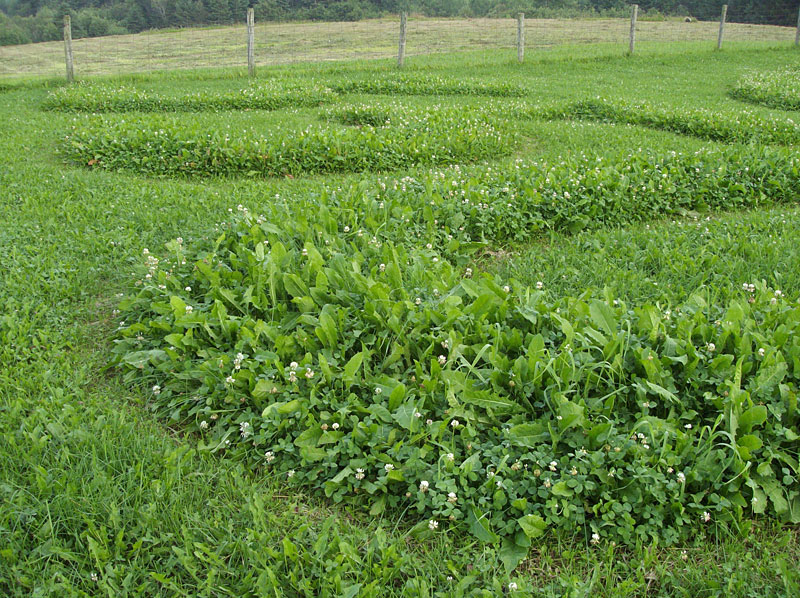
Site Contents
About Us
Contact Us
Events
Products
Scythe Buyers' Guide
Technical/
Instructional
Updates
Video
Home
350 Action
~ Peace be with the World ~
(A short reflection on this day of the International Day of Climate Action, October 24th 2009)As we now enter the next stage of the collective evolution in awareness, neither to simply smile (our sign's message in May), nor to frown (change in mood as of mid-summer) may serve us adequately in meeting all the challenges ahead. Thus, we had best learn how to maintain inner calm, a centre from which to spring into appropriate action.
 |
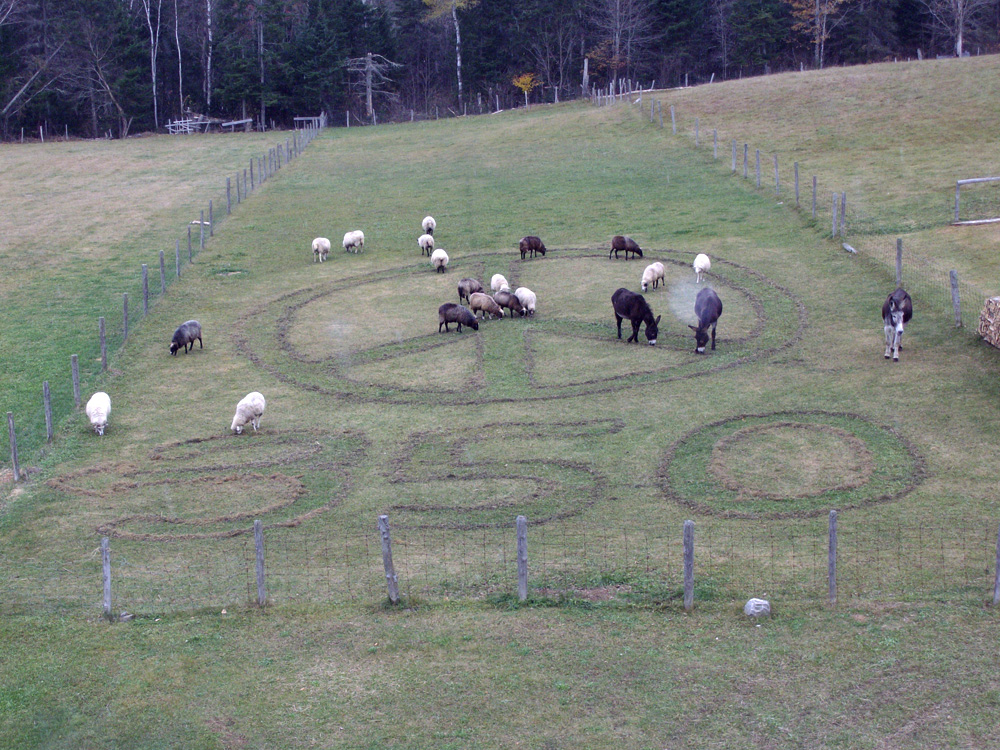 |
The peace symbol in this last version of our sign represents both -- the poise amidst climate-caused chaos and also hope that the growing tension on the scene of international politics will not result in yet more resource-related wars.
A note to those who followed the link from 350.org to this website:
Yes, we did help our animal friends to enact their activist desire -- by using scythes to refine the design. All this, after all, is cooperation in action, something we all have to learn more about in the days to come.
For any future sign-mowing activism, here are some practical hints:
There are two basic approaches to sign-making with the scythe, both of them functional but one decidedly better than the other.
(A note added later: There's actually a third method -- and it is the easiest one. See how we recently made the "350" artichoke and potato garden shown below.)
The first approach is simply to cut "350" into a field of standing grass, free-style, so to speak, without much measuring, staking, drawing strings etc. If such a sign is not too large and the mower(s) have a good sense of proportion/geometry, they can work without a pattern and get it done, more or less. Doing it this way takes less total time but it requires more scythe competence as well as a more select group; with other words, a smaller number of mowers (relative to the size of the design) can participate. Also, at least some of the tall grass surrounding the letters will inevitably be trampled in the process.
The second approach calls for more planning and somewhat more time overall. The difference is that, as opposed to cutting the design itself, you cut the area surrounding it. Its foremost benefit, however, is that at the very day the sign is to communicate its message, more people will be able to take part in "making it come alive" than in the case of the first, simpler approach. The three-dimensional touch also makes the message somehow more "real"; thus this is what we recommend you all do on October 24th.
The somewhat more involved process by which we have made the large and semi-permanent signs on this farm is communicated further below. While making the first 350/smile sign (shown above), we took a combination approach: only quick drawing/measuring and a little more freelance work than usual. Altogether it took three of us approximately three hours. But the sign is a rather miniature in comparison to our four large designs (shown below); the area where we placed this one (a fenced-in pasture) is only 70' (21m) wide with the numbers only 24' (7m) tall.
As you see, we didn't mow the actual surface of the sign per se, but rather the area around it. It is easier not to "mess it up" this way because the bulk of grass can be cut -- starting from the edges -- without first trampling it. That is, you gradually work towards the still undefined letters from all sides until the approximate zone of the letters themselves is reached. Then the exact shape is defined (by measuring or just stepping off the outline, placing a few stakes and or strings) and mown more carefully.
(See photos)
 |
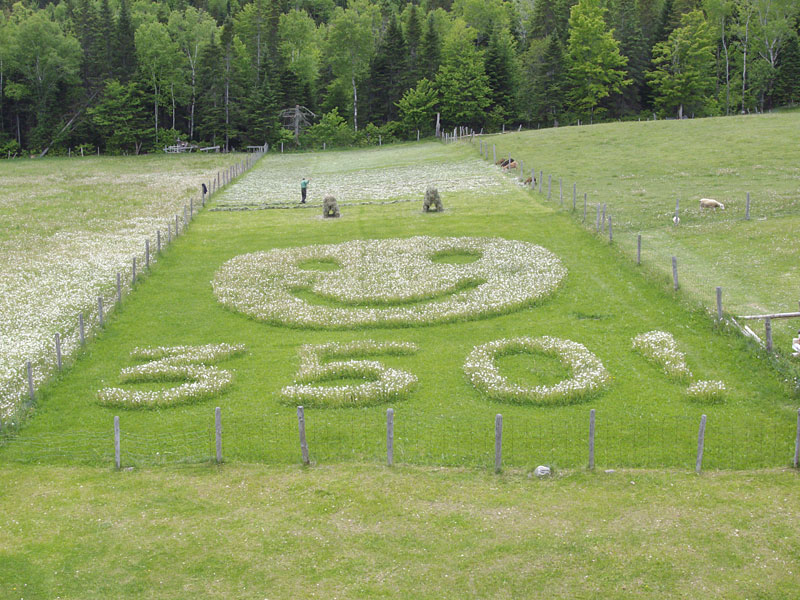 |
Two weeks later:
Dandelion blooms have turned to white fluffy seedheads.
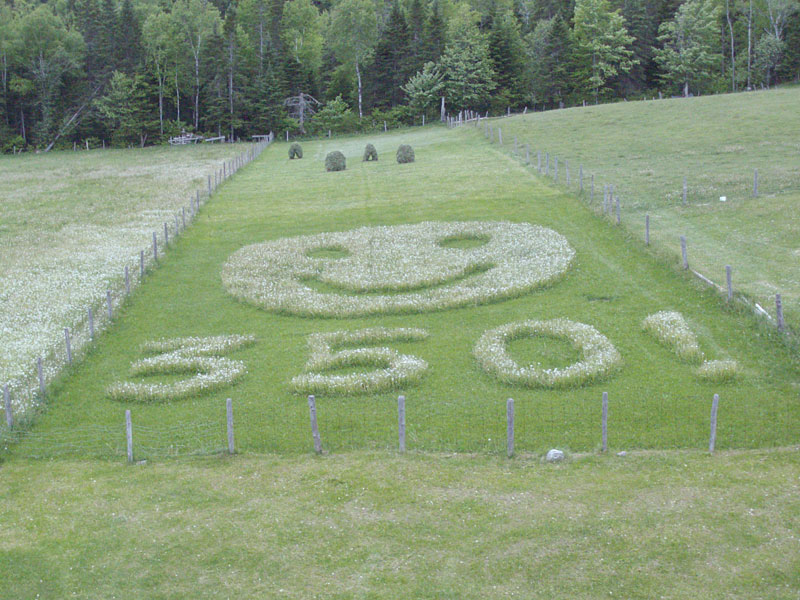 |
The rest of the pasture has been mown, with a portion of the grass already removed to feed (partly-dried) to the few animals which still spend the night in the barn, with some of it put into the hay loft. The curing hay racks seen in the background are an inevitable part of a haymaking system which enables us to process, what at this time of the growing season appear to be mostly rank dandelion stems (though it is not), into storable feed. (For more on this style of haymaking, see Handcrafted Hay.)
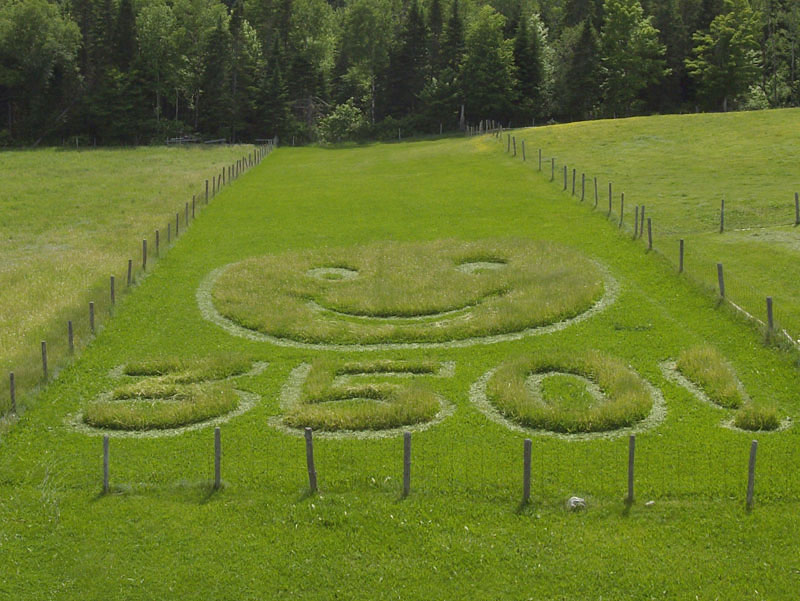 |
June 18: With the hay harvested, we quickly trimmed the design's outline. (This will make it easier to redefine after most of its first growth is transformed into flesh... and further fertility.)
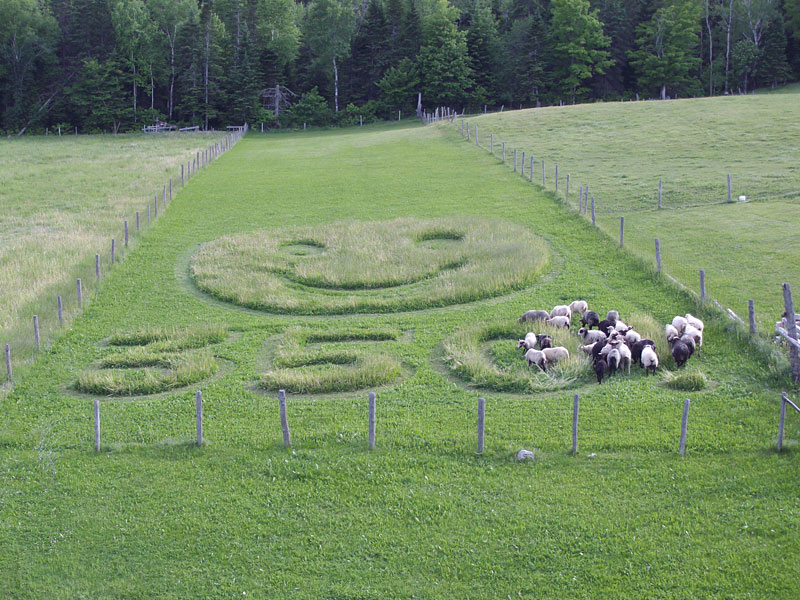 |
Later the same day the activist site is turned back into a pasture:
The sheep raced over from another part of the farm ahead of their guardians (the donkeys) and quickly read the whole message. Then, interestingly, they congregated over the "0" as if to suggest that they are set on zero SOMETHING. Could it be zero emissions? Hmmm... they wouldn't be that na´ve... Or, practicing some positive philosophy of living in the NOW -- as long as green grass is still available at their mouth's reach -- they perceive zero problem? But, we wonder, are sheep this smart? Could they have actually studied the fundamentals of Buddhism, for instance and grasped the essence, or are they just fooling around and reiterating the rhetoric? We really don't know.
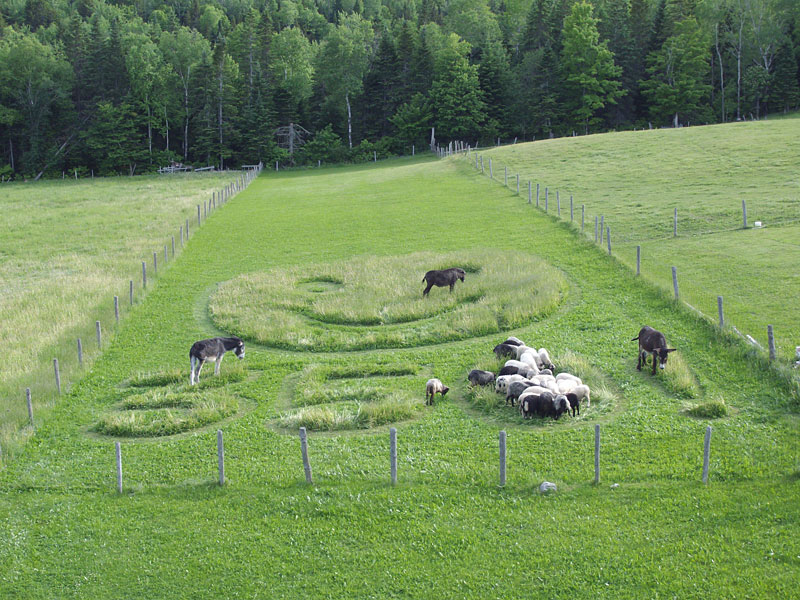 |
The donkeys, as you see, prefer not to make hasty moves. Instead they take their time to consider the options, while taking a nibble here and there. This, as all "donkey people" know, is very much in line with their contemplative nature. (We used to keep upwards of 20 donkeys for many years and are firmly of the opinion that whoever came up with the expression "dumb as an ass" was very uninformed, perhaps even outright dumb... Donkeys, in fact, may well be the wisest of all domestic animals and if we humans were as humble, undemanding and as considerate as they, this planet would surely not be in the mess it is now!)
But what exactly these three donkeys are now thinking while reading this design, we also do not profess to know. They may indeed consider it a joke, or alternately, feel that any attempt to raise awareness in general is a worthwhile pursuit. Perhaps as the season evolves, we'll get some grasp on the issue -- because they will have "re-made" that sign and contemplated its message at least a couple more times before Oct. 24.
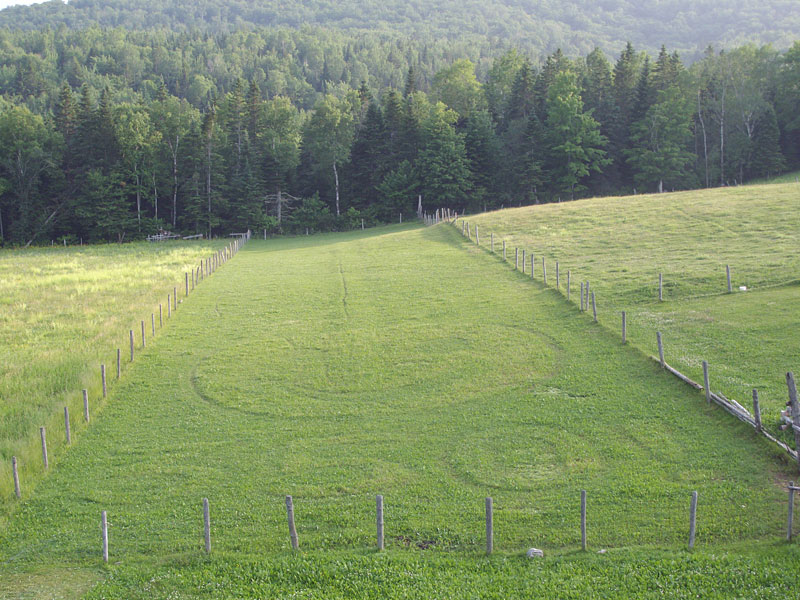 |
It took three days for those few animals to "erase" the design and graze down the rest of this one-acre pasture. We didn't take a photo on the day they were moved, but 4-5 days later the fast-growing white clover was beginning to bloom a little in the area surrounding the numbers.
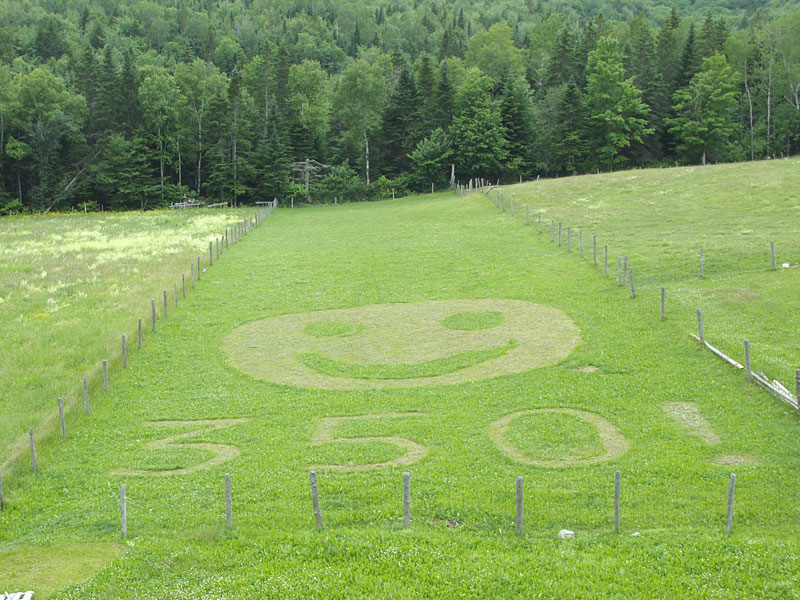 |
As the next step, we mowed the design itself for the first time; even though it doesn't appear as if there was anything that needed cutting, there was. As all farmers know, when livestock are offered abundance (of which on the first day this pasture was an example), they treat it like many children do a dinner plate with more on it than they need to get a bellyful: they waste some of it. Thus the overly tall grass comprising the sign was not grazed completely, but partly trampled.
We still consider it worthwhile to trim the leftovers because doing so will encourage new growth. The sign in this photo is more visible because the trimmings were spread to dry which provides the colour contrast. Even though they amount to very little storable dry matter, removing the trimmings will make the mowing of it next time around easier. (Most beginners, by the way, may have some difficulty cutting grass so very trampled and laid upon, simply because of the way their scythes are "set up" and sharpened and the technique used. I wish to emphasize that with a good scythe, well wielded, any growth can be trimmed literally to ground level ...the notion that a scythe is suited for the cutting of tall grass only is simply humbug!)
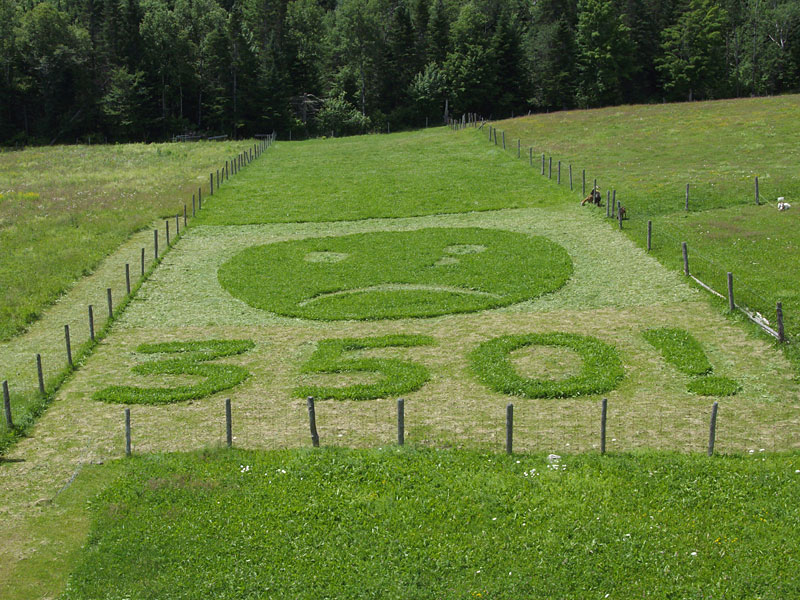 |
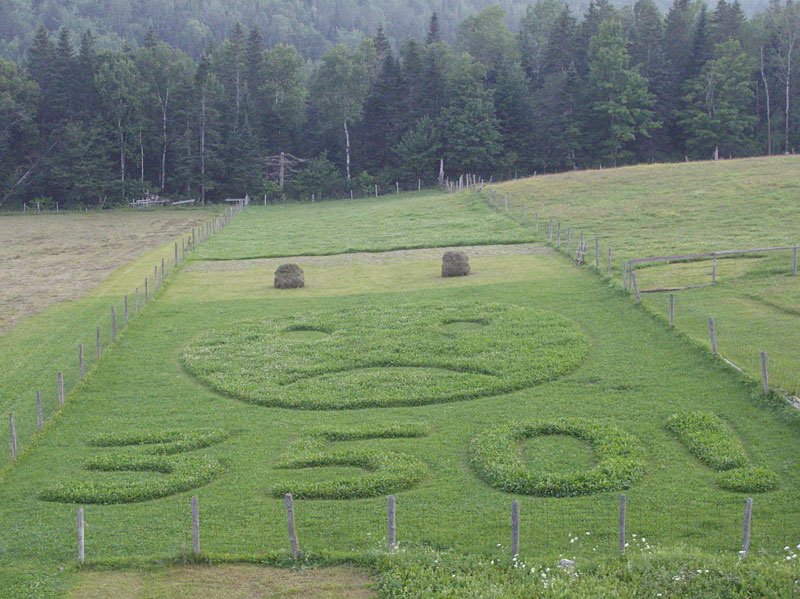 |
 |
 |
Another note of relevance:
Large designs, especially if made on a relatively flat surface, can only be fully seen from the air. But to fly a plane in order to photograph a pro-environment slogan is a somewhat hypocritical thing to do - in principle similar to Peak Oil/Climate Change (or for that matter scythe-promoting) activists flying around the globe to participate in what they perceive are meaningful events. The question of if and when "the ends can justify the means" has not to my knowledge been sorted out by anyone to the point that the answer has a straightforward and universal application. Still, that very question -- and attempts to answer it -- must never cease.
With pertinence to slogan-making we therefore urge everyone to consider mowing the signs in places where they can be well seen without the need for a plane. Some of the birds-eye views of our pre-2005 signs were air photos, but thanks to Ashley's monkey-like tendencies, many of the photos in this extended section were taken from the tops of surrounding trees. (A hot-air balloon or a glider would be another great alternative to hiring a private plane!) The small 350/smile design was photographed from the roof of a nearby barn. Here are some shots to provide a perspective.
An inclusion on June 10. (after receiving some feedback to the "Scythe-action 350")
Some respondents apparently thought that this was something to do on Oct 24th only; with a portion of them expressing concern that in their region there would not be any suitable grass left to cut by that time. Well, yes -- under normal circumstances, this would also be true in the area of New Brunswick, Canada that we live in. Especially before global warming shifted the local autumn-to-winter transition, we could, by that date, already have a snow cover serious enough to stay until the end of April the following year. However, we are not suggesting "normality", nor is Bill McKibben, for that matter; the era we are now entering is shaping up to be anything but normal -- and we will need to learn how to act accordingly -- i.e. "abnormally", and that in many ways... To what extent climate change can be mitigated by the collective effort of humanity from now on is a big question which even the top climate-scientists can't answer with any degree of accuracy. Still, to continue behaving "normally" is somewhat like subscribing to W. E. Deming's tongue-in-cheek comment "It is not necessary to change; survival is not mandatory"...
As we see it, the whole of 350 action is somewhat abnormal.
That is, under normal circumstances -- given the theoretical IQ of this species -- it should not be necessary. And, in this era so dominated by machines, it is particularly abnormal if some of these "calls to awareness" are made by means of acient versions of modern implements. Using, apart from scythes, sickles or machetes (for example, to cut the sign in the middle of a sugarcane plantation), would be equally meaningful. The added meaningfulness (to the 350 concept) lies in the fact that the "work" is accomplished with human-powered tools, rather than those dependant on diesel or gasoline. Although the availability of these fuels is presently still considered normal, this is likely to change in the near future. How near exactly, only God really knows... But we can already surmise that they may first become prohibitively expensive and/or rationed, and eventually difficult for common citizens to obtain at any price. Yes, biodiesel and ethanol will partially take their place, but so completely as to retain "normality"? Not a chance. Whatever will be the inevitable effects of the climatic changes, the future of agriculture -- which means the future of humanity -- lies in massive re-application of human hands and feet, a partial return to draft animals as our aids, plus a hell of a lot of ingenuity to boot!
To at least a portion of the readers of this website, all of that is no news -- hundreds of voices around the globe have been calling for some form of a more life-friendly alternative for decades. We have, of course, endorsed it all along. (See for instance our 2003 essay Conviviality and The Scythe.)
As already explained, while making the signs we simultaneously obtain feed for our animal friends, who in turn help provide our sustenance. As this whole "Mowers Artwork" section is meant to communicate -- activism, sustainable landscape care and ecological agriculture can be combined into a multi-purpose effort. It is precisely this that we hope many of the 350 sign-cutting activists will conclude. Those who create a sign which besides it's climate change-related message serves an additional life-sustaining purpose, will come closer to that realization. Cutting out a 350 with any hand tool and then utilizing the material as feed, mulch, thacth or insulation is but one example. Digging up a 350-shaped section of a lawn in some prominent city location (a park, for instance) and then planting vegetables and/or grains into it, is another one. Building (within some eco-village or some educational center) three livable "long houses" in the shape of a 3, 5 and 0 and then moving into them to demonstrate sustainable construction methods, as well as a communal living arrangement, is still another...
The recently-published A Nation of Farmers (Sharon Astyk and Aaron Newton) calls for 100 million additional farmers -- in the USA alone. Even though the authors do not appear to have seriously considered that, while not all grassland of this continent can realistically be expected to become vegetable gardens (to feed a nation of primarily vegetarians?), much of the seasonal growth of permanent grasslands can be turned into flesh in a very sustainable manner, we applaud their contribution to sanity in general, (and highly recommend that book as a must-read). They will probably come to the conclusion that, as Simon Farlie has put it -- "All flesh is grass". So will many others.
And if there is a more ecological tool than the scythe with which we can provide "roughage" for animals, (the only feed many of them need) I'd like to know what it is...
In any case, to give expression to Sharon's and Aaron's obsession with vegtables, and ours with scythes, we combined the two concepts into the experiment below.
July 4th is a preposterous time for starting a garden in this area (where by mid-September, sometimes sooner, we're sure to have received at least one killing frost). But we didn't manage it earlier, and being the American "Independence Day" it seemed, at least symbolically, a fitting one... so that was when we did it.
We were already planning to do this pioneer/emergency style of gardening experiment; and in support of the 350.org climate-related action, incorporating the 350 logo was only natural.
What is so pioneer-like about this approach? For one thing, the pioneers were -- by necessity of the times -- utter conservationists, at least initially. That is to say, they had to use available energy very carefully. (Those who failed to do so often died...) For another, they did not always expect that the living conditions in "the new promised land" would be as harsh. So often they actually were put to more of a survival test than in their respective homeland.
Well, to manifest the concept of "voluntary contraction" -- something that many authors have been writing about recently (although none of them are advocating the use of hand tools to the extent the situation already calls for), we used only two tools to create this garden-- the scythe and a hoe, and possibly even the hoe could be dispensed with. We'll see, because some of the potatoes and Jerusalem artichokes were simply laid on top of the freshly mown meadow and covered with the cut grass.
 |
Step 1.
We mowed the area and, using the scythe instead of a hay fork, gathered the cut forage into the shape of 350.
 |
Step 2.
Using a sturdy Italian pointed hoe (this soil is full of rocks) we removed small chunks of sod (each 14-16" along the line of the design) and left them laying simply inverted beside the shallow "holes".
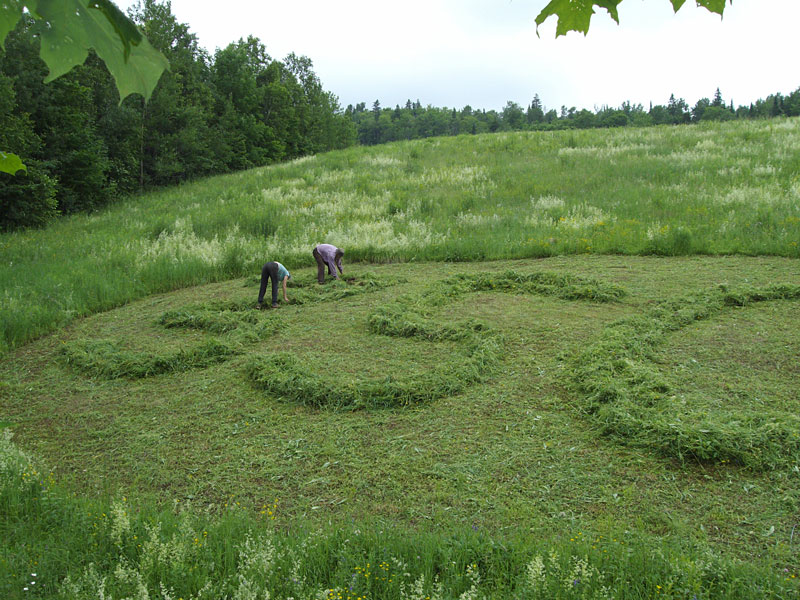 |
Step 3.
We placed the tubers into the holes and pushed the cut grass very close to them (though not yet quite over the top).
All in all this is less than three person/hours of activity -- which we consider fun rather than "work". Of course, in order to procure adequate mulching material to keep the sod "subdued", we'll need to expand the mown area as the season progresses. We'll report the success/failure of this project, how much total time it will have taken and how large an area will, in the end, be needed just to grow the mulch. The area surrounding the garden design itself will, of course, be cut again.
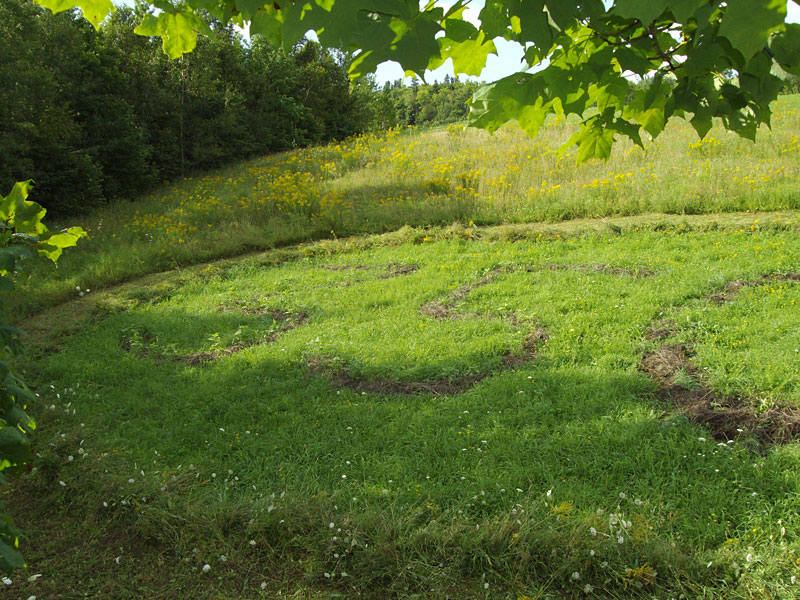 |
Blessed with a few days of fair weather in late July and early August, we focused on hay making and fall grain land preparation; in the meantime, the little 350 garden was left to fend for itself.
Neglect as such was not the idea to begin with -- but it added yet another less than favourable touch to the trial. Most of the artichokes and potatoes did survive and, however slowly, have been growing.
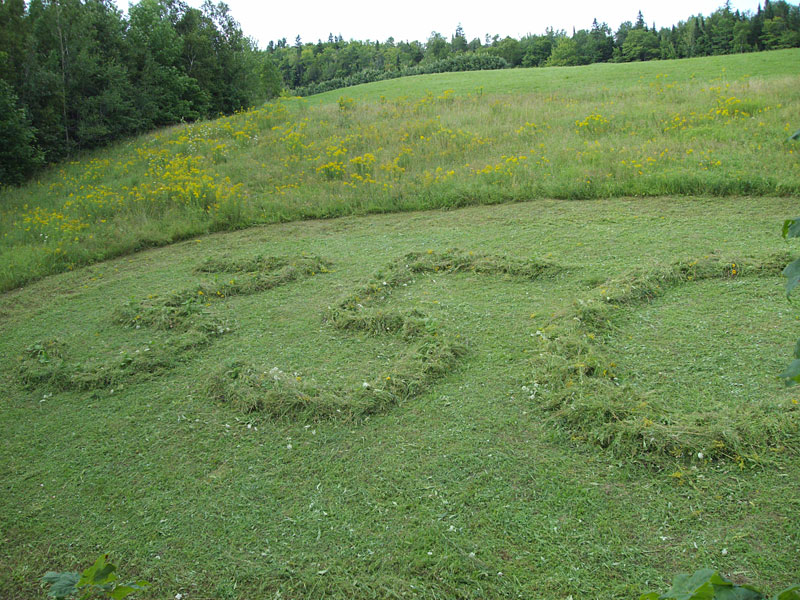 |
33 days from planting we spent another three person-hours to re-mow the surrounding area, as well as an additional strip of the meadow's (now rather mature) growth as mulching material. The two scythes were the only tools used at this step -- both to cut and then move the freshly cut grass from the windrow next to the planted design (whereupon it was hand-placed more carefully around the stems of the root crops/vegetables. The uninitiated (or even many somewhat experienced) scythe users can't quite imagine how this tool, so well designed for cutting, can also double as a rake and/or fork -- to either spread the windrows evenly for effective drying or gather it together to be put into a cart and/or place as mulch around the trunks of nearby fruit trees, etc.
Final note:
We lost the few photos taken at the end of the season while putting the garden to sleep. The harvest was expectedly meager and would not sustained the imagined "pioneers" for very long. Then again, given a real need, they'd have put considerably more into growing their food than the few hour we found time for (We do have several other sizable and well-tended plots .. and until the changes in the climate either fry or drown us, we are unlikely to starve.)
But at least the "survival garden" was begun. Next year we hope to do better...
A Handmade Garden for Hard Times
A note to those who have not read The Scythe-Made Garden (which discusses the rationale of this project) here is a brief summary:
In 2009, in order to further settle our already somewhat established notions about how - given emergencies and/or shortages of resources -- food can be grown with a minimum of tools and time input, we started two "pioneer" gardens. One is in a pasture only about 100m from our buildings (thus it received adequate attention) and the other in an old hayfield somewhat out of the way (and thereby sorely neglected). Both were deliberately placed in spots which a "normal" farmer living on this 200 acres of land would NOT pick for a garden.
In solidarity with the efforts of Bill McKibben, we chose 350 as the basic design around which one of these gardens would evolve in subsequent seasons.
The more intensely cultivated of the plots is briefly profiled in the commentary to the hoe-related videos, the story of the other (the 350 shaped one) is presented below, in both a short and more detailed version.
2010 season - the short version:
The initial working session took place on May 28; already about a month past an ideal date for the task.
The area was first trimmed clean with the scythe. Then, using the scythe blade as a rake (it works very well), we gathered the cut material into strategically placed piles to be subsequently used as mulch over the newly planted tubers.
This time the alternate zone (i.e. the area surrounding the 3, 5 and 0, rather than the outline of the numbers themselves) was planted with potatoes and Jerusalem artichokes (also called sunchokes), at more or less 2'/60cm centers. The holes were made by using the Magna Grecia hoe - a significant improvement in effectiveness over the hoe we used for the same job in 2009. One seed piece was placed into each hole, covered with the partially broken up chunks of sod and then loosely mulched with the freshly cut grass.
In spite of the seriously dry soil we did not water. We blessed the seed, prayed for rain and left the rest in the hands of the powers greater than ourselves.
We only returned on October 10 (the day of global 350 action work party) to find a wildly overgrown mere hint of a "garden". The potato vines were completely withered (several hard frosts had by then taken place) but the sunchokes looked still very alive, some of them blossoming.
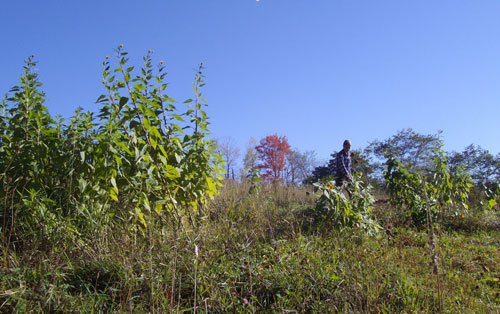 |
Again - to get oriented and find what was where - the first step was the trimming of the whole area with the scythe. Locating the remnants of mulch which had been placed over the tubers, we proceeded to loosen the soil with the hoe and retrieve the potatoes. The harvest - given the little time spent - was actually surprising.
(The photo below shows the yield of one potato plant.)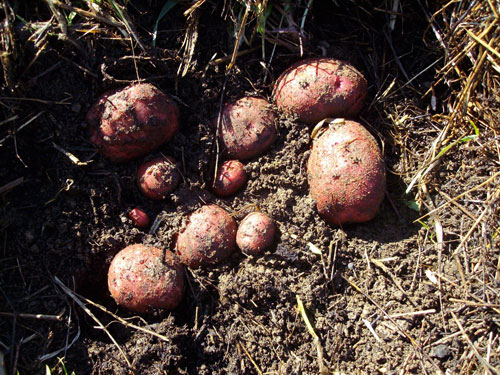 |
After gathering the gifts we placed some of them into a 350 formation and - on behalf of Bill McKibben - took a few pictures. (The 5 is made with the Jerusalem artichokes, the rest are potatoes.)
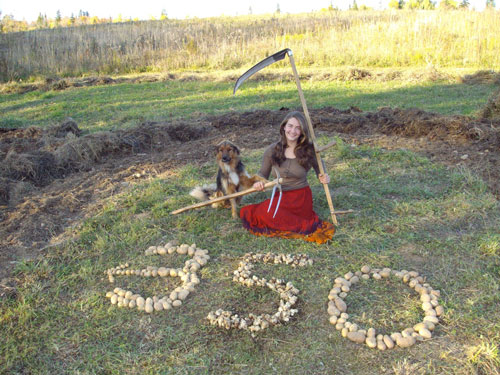 |
Then we dug up the 0 and planted approximately 2'/60cm wide inner strip of it with garlic and "multiplier" onions - about the only crops which at that time of year could still be planted in this area with any chance of a harvest next year.
The only tools used in this garden so far were the scythe and the hoe. (The dog, as you see, tried to claim the hoe - because he likes to dig; Ashley danced around with the scythe, but yes, she did help the dog with the digging as well.)
Taking the 2009 "scythe-made garden" to the next stage - a more detailed report on activity (or lack thereof...) in 2010.
"The best laid plans of mice and men go oft awry..."The plan was to expand this semi-wild garden's food-producing potential, of course.
The next step on the agenda was to dig up the surface of the numbers completely, remove the remnants of roots and thereby gain a significant area ready for small seeds. (As a result of the previous year's mulch over the tubers, the sod was already partially subdued and to work it up into a respectable seedbed would be now considerably easier.)
Then into this approximately 3'/90cm wide strip we planned to sow small grains - both in a solid stand (requiring no further care until harvest) as well as - for comparison -- clean row culture (which would be kept free of weeds by manual means). The area within the 0 and surrounding the 3 and 5 was to be planted with potatoes and artichokes and kept under mulch - to be dug up and turned into sod-less culture the following (2011) year.
That would have been a project for late April/early May... However, with typically "too many irons in the fire" (and not enough hands to always "hit the iron while it's hot") we did not find time to even visit the spot (which is somewhat out of the way of our usual spring activities) until May 28. By then the area appeared "beautifully wild" and showed hardly a trace of previous gardening activity. The sod from under last year's mulch was making a healthy comeback. (Here the stitch in time that would have saved nine was already missed.) Pondering over the situation, I had a flashback to the scenes from some of the Permaculture homesteads I've visited in Europe, and the shots of gardens in Natural Way of Farming - which made me feel better. We joked that Masanobu Fukuoka might actually be pleased, and decided to still go ahead.
Before trampling it, we trimmed the whole area with a scythe and gathered the cut grass into piles to be used as mulch immediately after planting.
Then, as in 2009, only a simple hole was prepared for each seed tuber. This took from one to three swings with a hoe (depending on how many rocks the blade confronted). We compared three different designs - the pointed hoe we used last year, one with two 8" /20cm long prongs and the heavier, longer-toothed Magna Grecia.
 |
The first two were quickly laid aside as incapable to compete with the third. A strong garden fork would be also have been fit for the job, but by then we had already learned that working in sod with rocky soil underneath some hoes were both faster and easier on the back. Last year we did it all with that pointed hoe (very left in the photo above). It accomplished the task, though our "new discovery" made the job this year notably easier. In addition, a considerably deeper loosening of the soil strata under each seed was possible - a decided plus, in our view.
After the planting was mostly finished we distributed the relatively scant amount of the available mulch where it was most needed (i.e. directly over the holes). A portion of the potential garden space remained untouched, due to time constraints on that day. We fully intended to return soon, plant the rest of the tubers, dig up the 3, 5 and 0 and plant the grain.
Rare for our maritime area at this time of year, we were experiencing an uncommonly hot spell. The soil was very dry when the potatoes were planted, and a few rainless days followed. We wondered if the seed would just wither before taking root, but "artificial" watering was not on the agenda of this "hard times gardening" experiment. Moreover, even what was on the agenda (some loving human attention -like hand picking the Colorado beetles and a little weeding) this garden did not receive, because the intended "soon" never came... However, "there is no great loss without some small gain".
Unsure how -- after a whole summer of complete neglect -- the garden would welcome us, we nearly abandoned it - at least for that season. It was Bill McKibben and his comrades' global work party that inspired us to not give up. And so on 10/10/10 we walked up to that neglected spot with tools in hand and apology in our heart.
The first impression: wilderness greater than in May. No sign that potatoes were ever planted here, or if so, where they may be hiding (because hard frosts - as we'd had by then - made the leftovers of their vines almost disappear).
Again, a half an hour with the scythe caused a rather instant transformation into something of a "civilized" domain -- an area we could readily inspect and decide on next the relevant step. The holes with tubers were found using the withering mulch as guideposts...
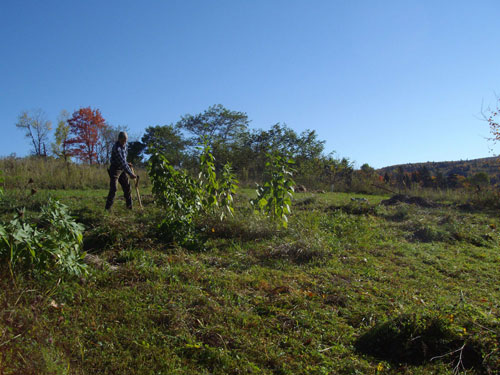 |
The potatoes were then retrieved, either with bare hands (from holes which happened to receive enough mulch initially to keep the resurrection of the sod somewhat in check) or by first carefully opening the hole with the hoe. The sunchokes' sturdy stems were initially pulled up -which yielded portion of the tubers - then the spot was loosened with the hoe and rest of them found.
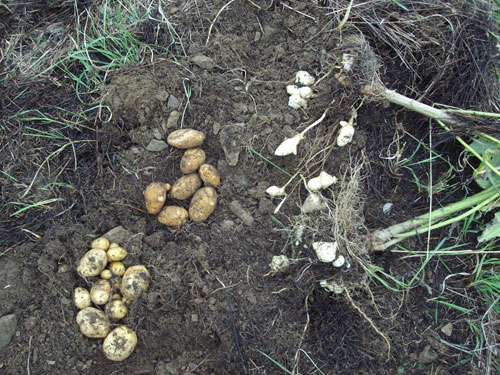 |
In the photo below the flowering sunchokes in the "3" are still standing and the "5" is only roughly dug. The "0" has been worked up to a fine seedbed, its inner oval planted in garlic. The outer edge -- the repository for the sod (first shook of its soil) removed from what now is the garlic/onion strip - was subsequently heavily mulched with scythe-mown vegetation from the field adjacent to the garden area. (This portion of what otherwise is a hayfield was saved (left uncut) as material to be used for periodic re-mulching of the garden throughout the summer. Had we managed to do so - a relatively small job - not only would this year's crop benefit but the sod would present less of a challenge during the harvest's as well as next spring's digging.
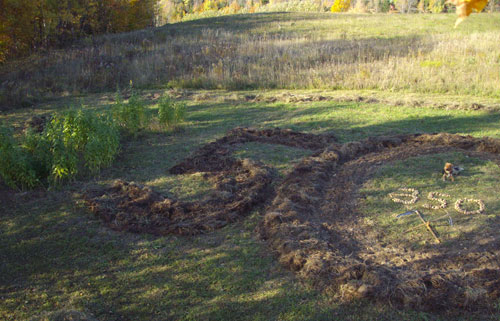 |
A portion of the crop of potatoes and sunchokes harvested from the "5" and "0" make up the 350 in the centre of the 0.
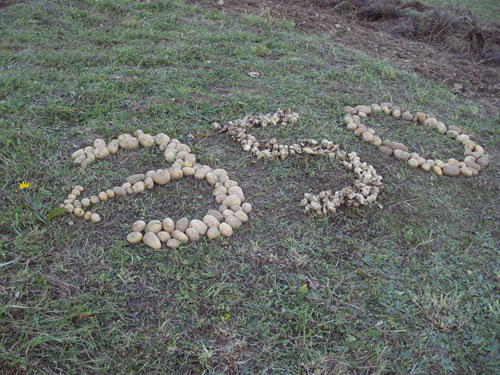 |
Conclusion:
What the title of this report implies by "further" was hardly an improvement over what we did with this garden the previous year. It turned out to be somewhat of an unintentional simulation of that stage of agriculture when a migrating band of hunter-gatherers would come by a place along their seasonal migration, poke holes in the ground with a digging stick, plant some seeds and move on, only to return in the fall to harvest whatever grew and matured without interim attention. Back then it was a smooth system.
However, we are settled farmers whose lack of periodic care is not to be excused - and we urge gardeners NOT to follow our example in this respect.
Due to the neglect during 2010 season we obviously "lost" the whole planned-for grain harvest, as well as, in all likelihood, a portion of the tuber yield.
The "gain", (after 36 years of learning!) was seeing with just how little input, both in terms of tools and time, food can sometimes be grown.
To be continued....
Modified 23 Feb. 2011
